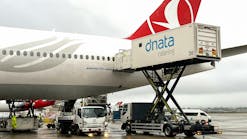Safety needs to be the top priority in aviation, whether in the air or on the ground.
When it comes to ground support operations, there are safety initiatives to help protect the people working on the ramp.
The National Air Transportation Association (NATA) held its inaugural Ground Handling Safety Symposium (GHSS) in Washington, D.C. The event allowed members of the industry to exchange ideas and share best practices for keeping ground operations safe.
During the GHSS, Sunshine McCarthy, vice president of business development and education at Baldwin Safety and Compliance, provided an overview of Safety Management Systems (SMS). The purpose of an SMS is to take a business approach to safety in order to identify hazards and mitigate them as much as possible before accidents occur.
“It’s a systematic approach to how you manage safety,” McCarthy says. “It has all the things that you would expect. It has accountabilities, it has organizational structure and, of course, it has policies and procedures.”
An important element of an SMS is, unlike older safety programs, there is not one person in charge of safety. Rather, an SMS requires responsibility from all members of an operation. McCarthy explains this attitude has to come from the top of an organization.
“You’ve got to have resources and support from the very, very top of the operation in order to have an SMS in place,” she says, noting that changing the culture around safety can lead to predicting and preventing dangerous situations.
SMS takes what a ground support team is already doing in regards to safety and provides additional organization around it.
“It’s not to say you’re operating an unsafe operation today. It just gives you some structure,” McCarthy explains.
Pillars of Safety
According to McCarthy, there are four pillars that support an SMS:
- Safety policy
- Safety risk management
- Safety assurance
- Safety promotion
Safety policy provides a statement explaining accountability for safety. A company creates an SMS manual with an outline of objectives as well as an emergency response plan. The safety policy should also identify key personnel designated to lead safety initiatives.
Because hazards always exist on the ramp, safety risk management is designed to identify underlying causes of dangers. Employees are often relied to report these matters. By having a safety reporting system in place, workers on the ramp can report small issues before they become larger threats to safety. Once a report is filed, it allows an operation to assess the risk and take steps to eliminate dangerous practices.
Safety assurance allows an organization to monitor steps put into place to ensure those measures work effectively. This may include performing an internal audit of operations and managing changes put into place to discover any potential safety implications.
Safety promotion is training and educating employees so that safety goals are clearly defined. Safety promotion is an ongoing process, requiring periodic SMS training for all team members.
“Those pillars all make up your culture,” McCarthy says.
She emphasizes that the pillars of an SMS are not linear, meaning they are not achieved one after the other.
“All the pillars and their elements all touch each other,” McCarthy says. “It’s very similar to how your operations work. All your departments touch each other. All your employees work together. You can’t have one without the other.
“That’s what an SMS is – it’s a system.”
IS-BAH Certification
In business aviation, an operation looking to establish an SMS can pursue International Standard for Business Aircraft Handlers (IS-BAH) certification
The International Civil Aviation Organization (ICAO) created standards and best practices, focusing initially on commercial airlines. From there, the International Business Aviation Council (IBAC) – a group under the ICAO purview, developed best practices and standards for business aviation. This included collaborating with NATA on ground handling safety measures outlined by the IS-BAH program.
There are three stages of certification in the IS-BAH program. Stage I certifies a safety structure has been put into place and is confirmed through an external audit. Stage II certification demonstrates an organization’s SMS is fully functioning. And Stage III proves a just culture and commitment to a strong safety environment.
“It takes a couple of years between each of one of these stages,” McCarthy explains. “It’s not something that happens overnight. It takes time, as it should, because it does take time, work, energy and resources in order to be fully functioning.”
She explains regulators were trying to find a way to oversee the numerous business aviation operations that exist. They decided that if an organization was managing its own safety, and could show how they were doing it, that would provide appropriate oversight.
IS-BAH certification can be beneficial to an operation beyond providing a safer work environment. Business can increase as operators are often looking for IS-BAH certified locations to ensure their aircraft will be handled safely on the ground.
“It clearly documents your approach to safety, so you can explain it to others,” McCarthy says. “It gives you control over what’s an acceptable level of risk for your operation. What may be acceptable for your operation, may not be acceptable for another one – or vice versa.
“You can demonstrate control to regulators, to shareholders and to customers.”
Other SMS and IS-BAH benefits can include decreased insurance costs and improved employee satisfaction.
But most importantly, it helps prevent incidents, injuries and damage to equipment.
SMS Requirements
SMS is required for commercial airlines, but it is not actually required for business aviation, McCarthy explains.
“However, what has happened is our industry has embraced it. And because the industry embraced it, the bar was raised,” she says. “For flight operations, if you don’t have an SMS today, you’re really at risk. If something were to happen, what would come out is that you weren’t even living up to industry standards.”
The bar for ground handling is being raised too, where more and more operators and FBOs are becoming IS-BAH registered and having an SMS. McCarthy adds that some insurance companies are giving incentives for their operators to have an SMS in place in an effort to reduce the rate of accidents, damage or injuries.
The IS-BAH program is growing with nearly 80 locations worldwide certified – and a handful have already completed Stage II.
McCarthy encouraged attendees of NATA’s GHSS to continuously work at safety culture, stressing the importance of evolving with new safety practices.
Installing an SMS is an opportunity to change a company’s culture and attitude toward safety.





